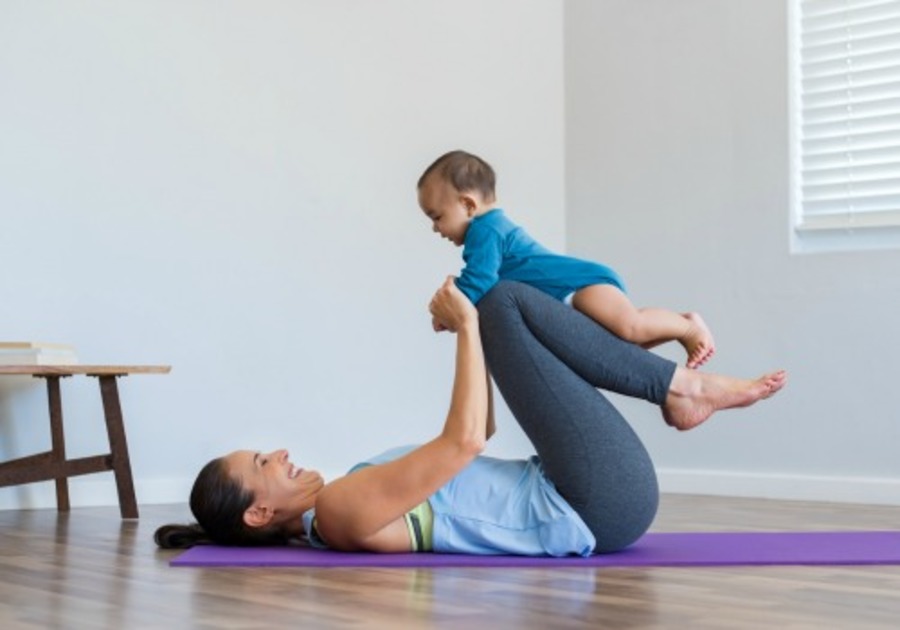While pregnancy is an exciting time, and the end result is worth the aches, pains, and discomfort, you cannot deny that the body undergoes a lot of change. After giving birth, your body may not feel the same as it did before you were pregnant. At some point, you will consider getting back to exercise and all the things you enjoyed before the baby was born. You are ready to exercise, but where do you start? Is it okay to just pick up where you left off? Should you start something new? How much is too much?
Every woman is different, and every body recovers at its own rate. The first rule of thumb is to respect your body. Do what feels good, slow down or stop if you experience any pain or something does not feel right. If you are unsure of what may be best, consider working with a physical therapist who specializes in postnatal health or pelvic health. Secondly, go slowly. Start by building a strong foundation and advancing your exercise program from that point as you feel stronger.
The following three exercises are great as a starting point and give you options to challenge yourself as soon as you feel you are ready. They can be done at home or in the gym, and you can even do them with your baby nearby or with your older kids trying to do them with you.
1. Diaphragmatic Breathing and Pelvic Floor Muscle Activation/Relaxation
The pelvic floor muscles (PFM) are susceptible to injury due to stretching throughout pregnancy and pushing during labor. Taking time to rehabilitate these muscles in the early postpartum period can improve or prevent these symptoms. The diaphragm’s primary role is to control breathing. It also makes up part of the deep core system (along with the low back muscles, abdominals, and PFM). Changes in posture during pregnancy can affect diaphragm function. Addressing breathing early in the postpartum period may improve not only overall endurance, but also the function of the abdominals and PFM.
- Start by lying on your back with your knees bent in a comfortable position.
- Take a deep breath in. Feel your ribs expand upward and outward, and your chest and belly rise.
- As you exhale, your ribs should move down and inwards, and the chest and belly should fall. (All 3 areas—chest, ribs, belly—should be involved. When these muscles are coordinated, that indicates good diaphragm function.)
- Once you feel comfortable with breathing, turn your focus to the PFM.
- As you inhale, the diaphragm contracts and flattens and the PFM relaxes and lengthens.
- When you exhale, the diaphragm relaxes, becoming more dome-like, and the PFM begins to contract. (A good image for what the PFM should be doing is to imagine you are using your vagina to squeeze and lift a kidney bean.)
- With each exhale, squeeze and lift the kidney bean. Work up to holding it for 10 seconds without holding your breath.
- Repeat this 10 times and practice twice a day.
2. All Fours Knee Lift
The all-fours position is a good way to not only address core control but also work on coordinating arm and leg movements. Many activities, such as running, require good control of both the upper and lower halves of the body. Using the legs also helps restore strength to the gluteal muscles.
- Begin on your hands and knees with your hands under your shoulders and your knees under your hips with a neutral spine (not arched or sway).
- Take one breath to prepare, activating the pelvic floor muscles as you exhale.
- On the next exhale, lift one knee off of the floor, enough that you could slide a piece of paper under it.
- Hold 5 seconds and return to start.
- Continue, alternating sides.
- For a challenge, try straightening one leg behind you without arching or twisting the trunk.
- Work up to three sets of 5 repetitions on each leg.
3. Side Plank
The side plank is a more challenging exercise than the other two but is a great exercise to start with to address hip strength and core control without over-working the abdominal muscles that may still be healing in the postpartum period.
- Begin lying on your side with your trunk propped on your forearm, hips stacked and knees bent.
- Take one breath to prepare and activate the PFM as you exhale.
- On the next breath, exhale.
- Imagine you are pulling the inner part of your support arm toward your torso, lift your ribs and then your hips. You will be in a side plank position.
- Hold for up to 10 seconds.
- For a challenge, begin with your legs straight.
- Work up to 10 repetitions on each side.
BLAIR GREEN, PT, DPT, OCS, co-author of "Go Ahead, Stop and Pee: Running During Pregnancy and Postpartum," is a Doctor of Physical Therapy with a focus on pre/post-natal health and wellness, the founder/CEO of Catalyst Physical Therapy, and a board-certified orthopedic specialist. Known as the “go-to” expert in her field, Dr. Green is also a Polestar-trained Pilates instructor and a Certified Manual Trigger Point Therapist. She serves as an instructor in the Physical Therapy program at Emory University and as a faculty member for several Physical Therapy continuing education companies.



